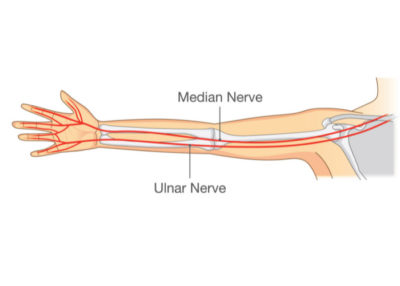Ulnar Nerve Transposition Surgeon

Are you experiencing tingling or numbness in the elbow, wrist, or fingers and specifically in the ring and pinky fingers. If so, you may have cubital tunnel syndrome, or a nerve that is pinched in your elbow. This elbow condition can be treated by a procedure called ulnar nerve transposition. Ulnar nerve transposition surgeon, Doctor Riley J. Williams provides diagnosis as well as surgical and nonsurgical treatment options for patients in Manhattan, Brooklyn, New York City and surrounding areas who are experiencing a pinched nerve in their elbow or cubital tunnel syndrome. Contact Dr. Williams’ team today!
What is ulnar nerve transposition?
Ulnar nerve transposition is an outpatient surgical procedure that treats ulnar nerve entrapment or cubital tunnel syndrome. The procedure involves moving the ulnar nerve (“the funny bone”), which runs at from top of the inner upper arm near the shoulder, across the inside of the elbow, and down to the fingers. The ulnar nerve is repositioned from its placement behind the medial epicondyle to an area above the condyle where it will not be compressed or stretched during normal elbow bending. Dr. Riley J. Williams, orthopedic elbow surgeon, serving Manhattan, Brooklyn, New York City, NY and surrounding areas, has extensive experience in successfully performing ulnar nerve transposition procedures.
What is ulnar nerve entrapment?
Ulnar nerve entrapment or compression may also be referred to as cubital tunnel syndrome. Ulnar nerve entrapment is responsible for tingling or numbness in the elbow, wrist, or fingers, specifically the ring and pinky fingers. This long nerve pass through a narrow soft tissue sleeve at the bottom of the medial elbow and is called the cubital tunnel. The nerve run behind the elbow and is stretched when the elbow is flexed or bent. Abnormal constriction or tension of the nerve in the cubital tunnel can lead to pain, numbness and tingling in the forearm and hand. Surgery may be necessary if the numbness and tingling substantially affect hand and finger motor skills.

How is ulnar nerve transposition performed?
Dr. Williams makes an incision by the medial epicondyle; he then carefully locates and exposes the ulnar nerve. A release of the nerve and neurolysis is performed. He then reposition the nerve to a different (more anterior) location on the inside of the elbow. The new placement will be superficial (subfascial), or within the muscle (submuscular). This relocation prevents the nerve from getting stretched or compressed in the cubital tunnel. Following the transposition, the nerve slackens with elbow flexion. Once surgery is completed, the elbow is placed in a bulky dressing and sling for about one week.
What are the risks of ulnar nerve transposition?
Risks from surgery may include:
- Infection
- Continued tingling due to incomplete decompression of the nerve
- Pain at the incision site
- Nausea, vomiting and/or constipation from prescribed pain medication
- Swelling
How long does it take to recover from cubital tunnel surgery?
A bulky dressing is used for about one week after surgery. Physical therapy begins 5-7 days after surgery and patients are encouraged to move their elbow right away. Prescribed pain medication (narcotics) may be advised for a finite period of time after the surgery to stay on top of pain before transitioning to an over-the-counter non-steroidal anti-inflammatory medication PT is recommended to restore mobility, strength and range of motion in the elbow, hand and fingers. Patients can increase their activity to tolerance once the wound is healed and range of motion is restored. A full recovery is expected over 2-4 months.
For additional resources on ulnar nerve transposition or to have your elbow pain evaluated, please contact the office of Dr. Riley J. Williams, MD, orthopedic elbow surgeon serving Manhattan, Brooklyn, New York City, NY and surrounding areas.
